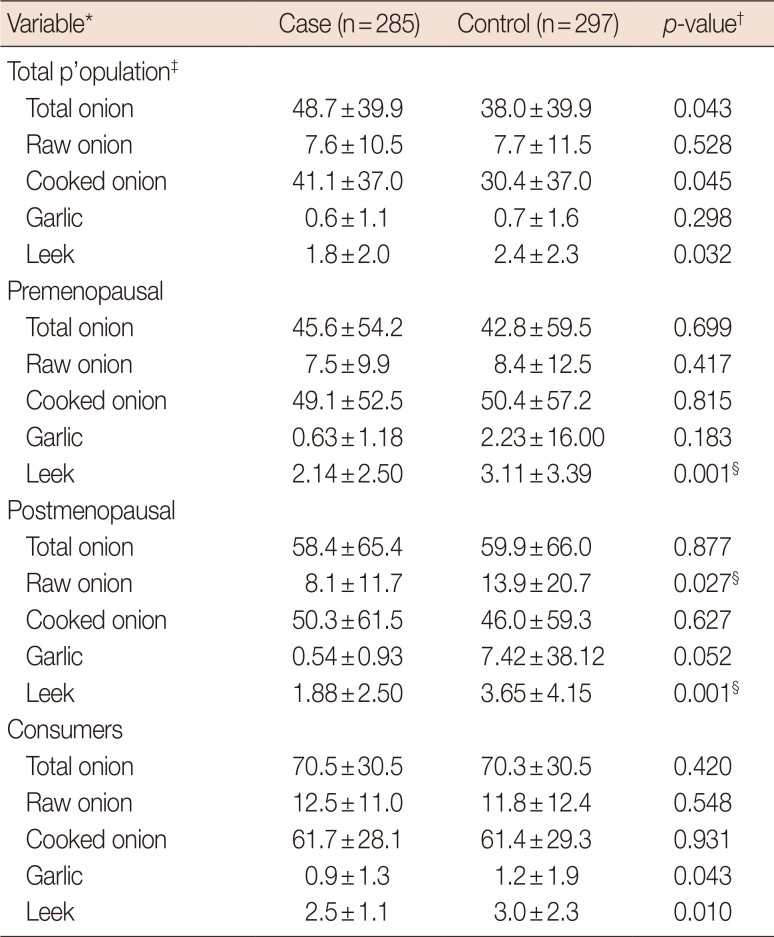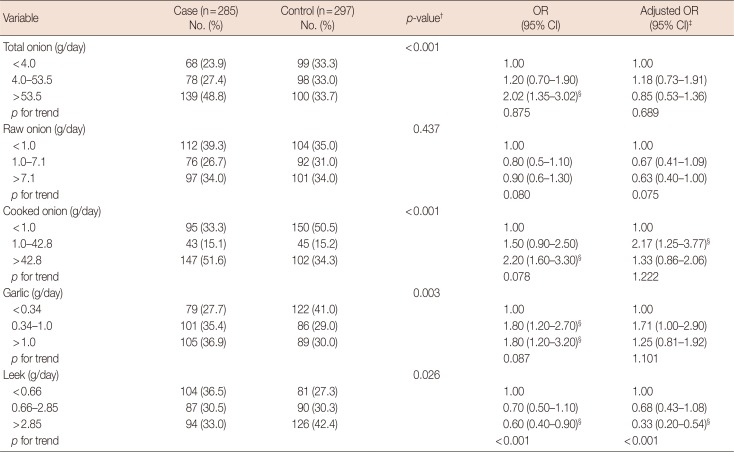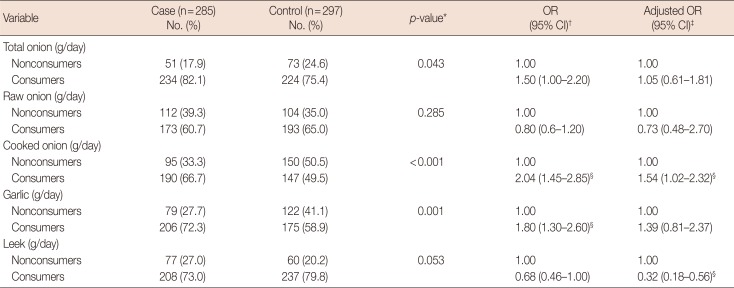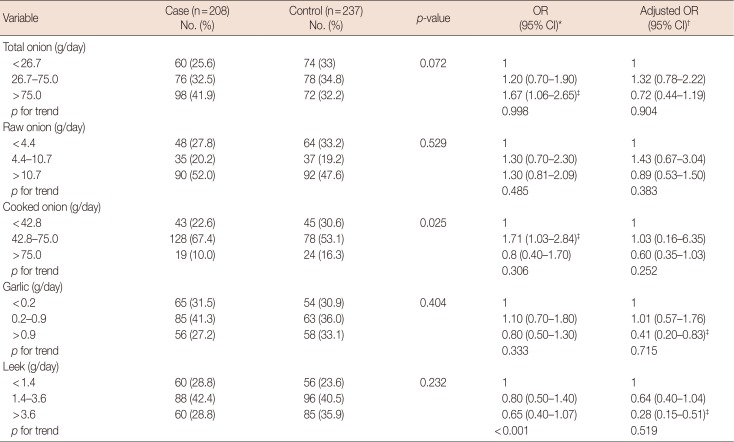1. Siegel RL, Miller KD, Jemal A. Cancer statistics, 2016. CA Cancer J Clin. 2016; 66:7–30. PMID:
26742998.

2. Mehdipour P, Pirouzpanah S, Kheirollahi M, Atri M. Androgen receptor gene CAG repeat polymorphism and breast cancer risk in Iranian women: a case-control study. Breast J. 2011; 17:39–46. PMID:
21159020.

3. Pirouzpanah S, Taleban FA, Abadi AR, Atri M, Mehdipour P. The association of plasma folate, vitamin B12 and homocysteine levels on hypermethylation status of RARbeta2 gene in primary breast carcinoma. Iran J Epidemiol. 2009; 5:19–27.
4. Cui X, Dai Q, Tseng M, Shu XO, Gao YT, Zheng W. Dietary patterns and breast cancer risk in the shanghai breast cancer study. Cancer Epidemiol Biomarkers Prev. 2007; 16:1443–1448. PMID:
17623805.

5. Bradbury KE, Appleby PN, Key TJ. Fruit, vegetable, and fiber intake in relation to cancer risk: findings from the European Prospective Investigation into Cancer and Nutrition (EPIC). Am J Clin Nutr. 2014; 100(Suppl 1):394S–398S. PMID:
24920034.

6. Norat T, Aune D, Chan D, Romaguera D. Fruits and vegetables: updating the epidemiologic evidence for the WCRF/AICR lifestyle recommendations for cancer prevention. Cancer Treat Res. 2014; 159:35–50. PMID:
24114473.

7. Bao PP, Shu XO, Zheng Y, Cai H, Ruan ZX, Gu K, et al. Fruit, vegetable, and animal food intake and breast cancer risk by hormone receptor status. Nutr Cancer. 2012; 64:806–819. PMID:
22860889.

8. Challier B, Perarnau JM, Viel JF. Garlic, onion and cereal fibre as protective factors for breast cancer: a French case-control study. Eur J Epidemiol. 1998; 14:737–747. PMID:
9928867.
9. Pirouzpanah S, Hanaee J, Razavieh SV, Rashidi MR. Inhibitory effects of flavonoids on aldehyde oxidase activity. J Enzyme Inhib Med Chem. 2009; 24:14–21. PMID:
18608746.

10. Sun-Waterhouse D, Smith BG, O'Connor CJ, Melton LD. Effect of raw and cooked onion dietary fibre on the antioxidant activity of ascorbic acid and quercetin. Food Chem. 2008; 111:580–585.

11. Charalampopoulos D, Rastall RA. Prebiotics in foods. Curr Opin Biotechnol. 2012; 23:187–191. PMID:
22244693.

12. Tepe B, Tuncer E, Saraydın SU, Ozer H, Sen M, Karadayi K, et al. Antitumoral effects of Allium sivasicum on breast cancer in vitro and in vivo. Mol Biol Rep. 2013; 40:597–604. PMID:
23065225.

13. Sengupta A, Ghosh S, Bhattacharjee S. Allium vegetables in cancer prevention: an overview. Asian Pac J Cancer Prev. 2004; 5:237–245. PMID:
15373701.
14. Tajaddini A, Pourzand A, Sanaat Z, Pirouzpanah S. Dietary resistant starch contained foods and breast cancer risk: a case-control study in northwest of Iran. Asian Pac J Cancer Prev. 2015; 16:4185–4192. PMID:
26028070.

15. Pirouzpanah S, Taleban FA, Mehdipour P, Atri M, Hooshyareh-rad A, Sabour S. The biomarker-based validity of a food frequency questionnaire to assess the intake status of folate, pyridoxine and cobalamin among Iranian primary breast cancer patients. Eur J Clin Nutr. 2014; 68:316–323. PMID:
24169462.

16. Pirouzpanah S, Taleban FA, Mehdipour P, Atri M, Foroutan-Ghaznavi M. Plasma total homocysteine level in association with folate, pyridoxine, and cobalamin status among Iranian primary breast cancer patients. Nutr Cancer. 2014; 66:1097–1108. PMID:
25157842.

17. Pirouzpanah S, Taleban F, Sabour S, Mehdipour P, Atri M, Farrin N, et al. Validation of food frequency questionnaire to assess folate intake status in breast cancer patients. Razi J Med Sci. 2012; 18:31–41.
18. Ghaffarpour M, Housyar-Rad A, Kianfar T. The Manual for Household Measures, Cooking Yields Factors and Edible Portion of Food. Tehran: Keshavarzi Press;1999.
19. Fleischauer AT, Poole C, Arab L. Garlic consumption and cancer prevention: meta-analyses of colorectal and stomach cancers. Am J Clin Nutr. 2000; 72:1047–1052. PMID:
11010950.

20. Milner JA. A historical perspective on garlic and cancer. J Nutr. 2001; 131:1027S–1031S. PMID:
11238810.

21. Dorant E, van den Brandt PA, Goldbohm RA. Allium vegetable consumption, garlic supplement intake, and female breast carcinoma incidence. Breast Cancer Res Treat. 1995; 33:163–170. PMID:
7749142.

22. Ronco A, De Stefani E, Boffetta P, Deneo-Pellegrini H, Mendilaharsu M, Leborgne F. Vegetables, fruits, and related nutrients and risk of breast cancer: a case-control study in Uruguay. Nutr Cancer. 1999; 35:111–119. PMID:
10693163.

23. Franceschi S, Favero A, La Vecchia C, Negri E, Dal Maso L, Salvini S, et al. Influence of food groups and food diversity on breast cancer risk in Italy. Int J Cancer. 1995; 63:785–789. PMID:
8847134.

24. Adzersen KH, Jess P, Freivogel KW, Gerhard I, Bastert G. Raw and cooked vegetables, fruits, selected micronutrients, and breast cancer risk: a case-control study in Germany. Nutr Cancer. 2003; 46:131–137. PMID:
14690788.

25. Asefi N, Mozaffari M. Effects of drying, packaging, and temperature on the quality of fried onion slices. J Food Sci. 2010; 75:S251–S254. PMID:
20629896.

26. Miglio C, Chiavaro E, Visconti A, Fogliano V, Pellegrini N. Effects of different cooking methods on nutritional and physicochemical characteristics of selected vegetables. J Agric Food Chem. 2008; 56:139–147. PMID:
18069785.

27. Song K, Milner JA. The influence of heating on the anticancer properties of garlic. J Nutr. 2001; 131:1054S–1057S. PMID:
11238815.

28. Setiawan VW, Yu GP, Lu QY, Lu ML, Yu SZ, Mu L, et al. Allium vegetables and stomach cancer risk in China. Asian Pac J Cancer Prev. 2005; 6:387–395. PMID:
16236005.
29. Malki A, El-Saadani M, Sultan AS. Garlic constituent diallyl trisulfide induced apoptosis in MCF7 human breast cancer cells. Cancer Biol Ther. 2009; 8:2175–2185. PMID:
19823037.

30. Henderson BE, Feigelson HS. Hormonal carcinogenesis. Carcinogenesis. 2000; 21:427–433. PMID:
10688862.










 PDF
PDF ePub
ePub Citation
Citation Print
Print


 XML Download
XML Download